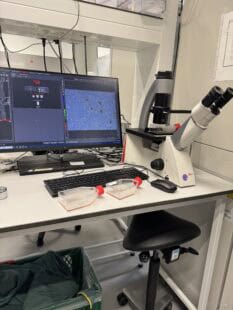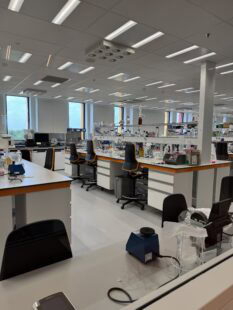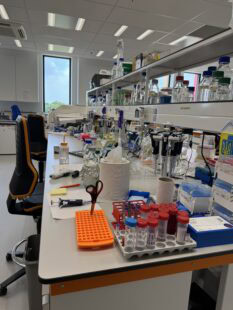Opening New Doors in DIPG Research: A Conversation with ChadTough Fellow Aimee du Chatinier
The ChadTough Defeat DIPG Foundation is committed to fueling bold, innovative research by supporting the next generation of scientists through its Fellowship Grant Program. One of those rising stars is Aimee du Chatinier, a predoctoral fellow at the Princess Máxima Center for Pediatric Oncology in the Netherlands, whose work is focused on overcoming DIPG’s resistance to standard treatments through powerful drug combinations.
With ChadTough’s support, Aimee is investigating a promising three-part therapy that pairs radiotherapy with two drugs: Paxalisib, currently in clinical trials for DIPG, and Givinostat, a drug being tested for Duchenne muscular dystrophy that has shown potential against DIPG in early studies. Her lab has found that Givinostat, even at low doses, can kill DIPG cells and enhance the effects of both radiation and Paxalisib. Early data also suggest it may help stimulate the immune system to fight the tumor.
In the first year of her fellowship, Aimee focused on finding the safest and most effective dosing strategy in immunocompetent DIPG mouse models. Guided by data from the PNOC/DMG-ACT1 trial, her team adopted a clinically relevant dosing approach for Paxalisib and included the use of metformin to manage side effects. They tested nine different combinations of Givinostat and Paxalisib, and while some regimens caused side effects due to how the drug is delivered in mice, they also saw near-complete tumor regression in some cases—a hopeful sign. Now in the final stages of this preclinical work, Aimee and her team are preparing for survival studies that could pave the way toward future clinical trials.
We had the chance to speak with Aimee about her research, what drives her, and how support from ChadTough is helping accelerate the path to better treatment options for kids battling DIPG.
CTDDF: Can you tell us a bit about yourself and how you decided to work in your field?
AdC: My name is Aimée du Chatinier, I’m 28 years old and currently in the final year of my PhD at the Princess Máxima Center for Pediatric Oncology in the Netherlands. I’ve always been fascinated by biology, especially how the human body works and what happens when things go wrong at the cellular level. Even as a child, I’d visit hospitals during open days just to watch pathologists at work, completely captivated by how they studied illness under a microscope.
By the time I was in high school, I knew I wanted to study Biomedical Sciences (though I had to explain to my family what that meant, since they don’t come from a medical background). During my Bachelor’s and later my Master’s in Oncology, I gained hands-on research experience in both neurophysiology and cancer research across several hospitals and institutes, including the Netherlands Cancer Institute. Being in clinical settings and hearing directly from patients made a strong impression on me and reinforced my interest in research that’s closely connected to patient care and outcomes.
While I was still studying, I watched the Princess Máxima Center being built, and I instantly knew I wanted to be part of it. It’s such a unique place where all pediatric oncology care and research in the Netherlands come together. For me, it brings together everything I am passionate about – brain science, cancer research, and the drive to make a difference for children facing devastating diagnoses.
That passion led me to the lab of Dr. Esther Hulleman. I first joined as an intern and was lucky to continue as a PhD candidate. Since then, I’ve been focused entirely on improving therapies for children with diffuse midline gliomas, including DIPG.
CTDDF: Tell us about the goal of your research and what you have learned so far?
AdC: The ultimate goal of my research is, without question, to help develop truly effective treatments for DMG/DIPG patients. I’m especially focused on how we can strategically combine existing therapies – like targeted drugs, radiation, and immunotherapy – in a way that makes tumor cells more vulnerable to each one.
To do this, we’ve developed a unique mouse model in our lab that includes a functioning immune system, something that many traditional models lack. This makes our research more reflective of what actually happens in the human body.
One important thing we’ve discovered is that the immune system itself can sometimes limit how well these treatments work in DIPG. This may help explain why many therapies that looked promising in older models haven’t lived up to expectations in patients. Understanding this interaction is key to designing better, more effective treatment strategies moving forward.
CTDDF: What do you hope the impact will be once your research is completed?
AdC: Over the years, I’ve identified a promising combination of two drugs alongside radiotherapy that I continue to study and refine. My hope is that this approach can eventually become part of a broader treatment strategy – a carefully planned sequence of therapies that work together to slow tumor growth and, ultimately, help extend life, even if it’s just by a little at first.
What drives me is the belief that no single treatment will be the answer on its own. But if we can combine the best insights from researchers around the world – each working on different pieces of the puzzle – we can find smarter ways to outmaneuver this tumor. My goal is to help create that roadmap for combination therapies that keep the tumor suppressed, and one day, maybe even eliminate it altogether.
CTDDF: What do you feel is the importance of private funding, such as grants from the ChadTough Defeat DIPG Foundation, in moving the field forward?
AdC: The support from the ChadTough Defeat DIPG Foundation is truly invaluable. It goes far beyond funding; it fuels our daily work in the lab and creates real momentum in the fight against DIPG. Private funding like this makes it possible to pursue bold ideas that might not yet qualify for larger institutional grants but could lead to major breakthroughs.
Just as importantly, ChadTough has created a global community. Through their efforts, I’ve been able to connect directly with DIPG clinicians, nurses, and fellow researchers from so many places. These collaborations and conversations help us stay grounded in what truly matters: finding treatments that make a real difference for children and families facing this devastating disease.






